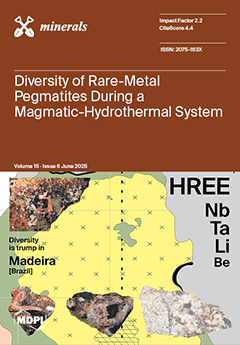Open AccessEditor’s ChoiceArticle
Revisiting the Permian Stratigraphy of the Kuznetsk Coal Basin (Siberia, Russia) Using Radioisotopic Data: Sedimentology, Biotic Events, and Palaeoclimate
by
Vladimir V. Silantiev, Yaroslav M. Gutak, Marion Tichomirowa, Alexandra Käßner, Anna V. Kulikova, Sergey I. Arbuzov, Nouria G. Nourgalieva, Eugeny V. Karasev, Anastasia S. Felker, Maria A. Naumcheva, Aleksandr S. Bakaev, Lyubov G. Porokhovnichenko, Nikolai A. Eliseev, Veronika V. Zharinova, Dinara N. Miftakhutdinova and Milyausha N. Urazaeva
Viewed by 1363
Abstract
The radioisotopic dating of five stratigraphic levels within the Permian succession of the Kuznetsk Coal Basin refined the ages of the corresponding stratigraphic units and, for the first time, enabled their direct correlation with the International Chronostratigraphic Chart, 2024. The analysis revealed significant
[...] Read more.
The radioisotopic dating of five stratigraphic levels within the Permian succession of the Kuznetsk Coal Basin refined the ages of the corresponding stratigraphic units and, for the first time, enabled their direct correlation with the International Chronostratigraphic Chart, 2024. The analysis revealed significant discrepancies between the updated ages and the previously accepted regional scheme (1982–1996). A comparison of regional stratigraphic units’ durations with estimated coal and siliciclastic sediment accumulation rates indicated that the early Permian contains the most prolonged stratigraphic hiatuses. The updated stratigraphic framework enabled re-evaluating the temporal sequence of regional sedimentological, volcano–tectonic and biotic events, allowing for more accurate comparison with the global record. Palaeoclimate reconstructions indicated that during the early Permian, the Kuznetsk Basin was characterised by a relatively warm, humid, and aseasonal climate, consistent with its mid-latitude position during the Late Palaeozoic Ice Age. In contrast, the middle-to-late Permian shows a transition to a temperate, moderately humid climate with pronounced seasonality, differing from the warmhouse conditions of low-latitude palaeoequatorial regions. The latest Lopingian reveals a distinct trend toward increasing dryness, consistent with global palaeoclimate signals associated with the end-Permian crisis.
Full article
►▼
Show Figures





